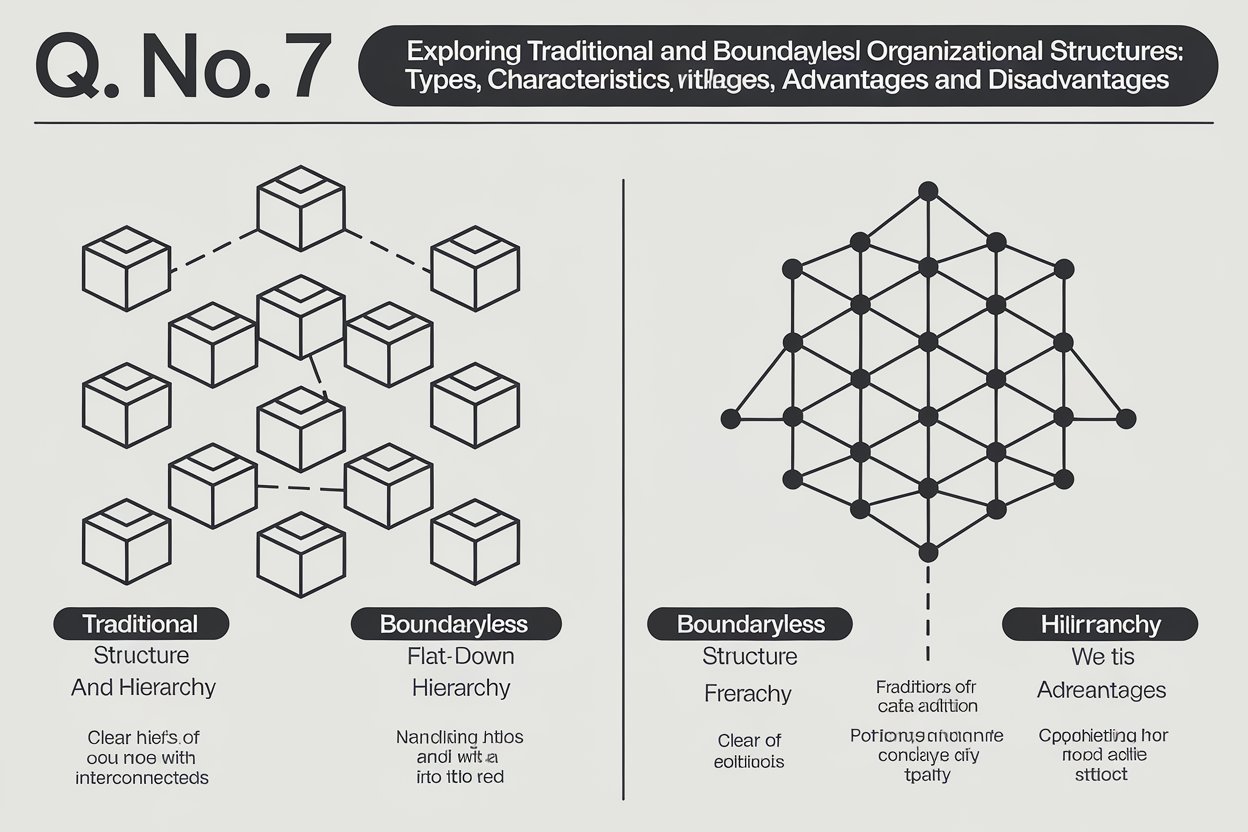Q. No. 7 Exploring Traditional and Boundaryless Organizational Structures: Types, Characteristics, Advantages and Disadvantages

Traditional vs. Boundaryless Organizational Structures: Types, Characteristics, Advantages and Disadvantages
Organizational structures define how a company arranges its workforce, departments, and communication channels. Two major forms are traditional organizational structures and boundaryless organizations. Each has distinct types, characteristics, and benefits.
Traditional Organizational Structures
Traditional structures follow a hierarchical framework with clear lines of authority and defined roles. These structures are common in larger, established firms.
Types of Traditional Structures:
- Functional Structure:
- Employees are grouped based on specific functions (e.g., marketing, finance, HR).
- Characteristics: Clear departmental divisions; specialization within functions.
- Advantages: Efficiency through specialization, clear roles and accountability.
- Disadvantages: Silo mentality, limited cross-departmental collaboration.
- Divisional Structure:
- The company is divided into semi-autonomous divisions, often based on product lines or geographic areas.
- Characteristics: Each division has its own functional units (e.g., sales, operations).
- Advantages: Greater flexibility and focus on specific markets or products.
- Disadvantages: Duplication of resources, potential for internal competition.
- Matrix Structure:
- Combines functional and divisional structures, with employees reporting to both functional managers and project/division managers.
- Characteristics: Dual authority structure, complex reporting lines.
- Advantages: Promotes flexibility and collaboration across departments.
- Disadvantages: Can cause confusion over reporting and authority, risk of conflict between managers.
Characteristics of Traditional Structures:
- Hierarchy: Clearly defined levels of authority.
- Specialization: Employees are focused on specific tasks.
- Centralized Decision-Making: Decisions are made by top management.
- Formal Communication Channels: Communication follows pre-established routes.
Advantages of Traditional Structures:
- Clarity and Control: Clear authority and responsibility help in managing large organizations.
- Efficiency: Specialization can lead to high productivity.
- Stability: Well-defined processes and structure provide predictability.
Disadvantages of Traditional Structures:
- Rigidity: Lack of flexibility can slow decision-making and adaptation to change.
- Silos: Departments can become isolated, leading to poor communication.
- Limited Innovation: Hierarchical structures can stifle creativity and responsiveness.
Boundaryless Organizations
Boundaryless organizations are designed to eliminate traditional barriers between departments, levels of management, and even external organizations. These structures promote flexibility, collaboration, and open communication.
Types of Boundaryless Organizations:
- Flat Structure:
- Fewer hierarchical levels, with a greater focus on horizontal communication and decision-making.
- Characteristics: Decentralized decision-making, employee empowerment.
- Advantages: Quick decision-making, high adaptability.
- Disadvantages: Can lead to lack of clear authority, potential for chaos in large organizations.
- Network Structure:
- The organization relies on external partners and networks (e.g., suppliers, distributors) to perform key functions.
- Characteristics: Outsourced tasks, strong reliance on partnerships.
- Advantages: Flexibility, reduced overhead costs, access to external expertise.
- Disadvantages: Loss of control over certain operations, reliance on external entities.
- Virtual Structure:
- The organization operates primarily through digital communication, with employees often working remotely.
- Characteristics: Minimal physical infrastructure, flexible workforce.
- Advantages: Cost efficiency, access to global talent, high flexibility.
- Disadvantages: Challenges in maintaining organizational culture, potential communication issues.
- Modular Structure:
- The organization focuses on its core competencies, outsourcing non-core activities to specialized providers.
- Characteristics: Modular design, reliance on outsourcing.
- Advantages: Focus on strengths, scalability, cost savings.
- Disadvantages: Coordination challenges, dependency on external partners.
Characteristics of Boundaryless Organizations:
- Decentralized Authority: Decision-making is spread across the organization.
- Collaboration: Emphasis on teamwork and collaboration across departments and organizations.
- Open Communication: Fewer barriers to communication, both internally and externally.
- Flexibility: Ability to adapt quickly to market changes.
Advantages of Boundaryless Organizations:
- Increased Innovation: Open communication and collaboration foster creativity.
- Adaptability: Quick response to changes in the environment.
- Employee Empowerment: Employees have more autonomy, leading to greater motivation and engagement.
- Cost Efficiency: Less hierarchical management reduces overhead costs.
Disadvantages of Boundaryless Organizations:
- Coordination Challenges: Lack of clear authority can make it difficult to manage large, complex projects.
- Potential for Chaos: Without structured processes, organizations can face operational inefficiencies.
- Cultural Challenges: In virtual or network structures, maintaining a cohesive organizational culture can be difficult.
Comparison of Traditional and Boundaryless Structures
| Aspect | Traditional Structure | Boundaryless Structure |
|---|---|---|
| Hierarchy | Clear hierarchical levels | Flattened or no hierarchy |
| Decision-Making | Centralized | Decentralized |
| Communication | Formal and vertical | Open and horizontal |
| Adaptability | Less flexible, slower to adapt | Highly adaptable and responsive |
| Innovation | Limited by bureaucracy | Encourages creativity and innovation |
| Control | Tight control through management | Control may be diffuse or outsourced |
| Employee Empowerment | Limited, based on hierarchical level | High, with more autonomy for individuals |
| Cost Structure | Higher due to layers of management | Lower costs due to fewer managerial roles |
Conclusion
Traditional organizational structures provide stability, efficiency, and control, making them suitable for large or established organizations. However, they may be slow to adapt and lack flexibility. On the other hand, boundaryless organizations foster innovation, collaboration, and adaptability, which are essential in fast-changing environments, though they may face coordination challenges and require strong communication to function effectively. Both structures have their place, and the choice between them depends on the organization’s goals, industry, and size.